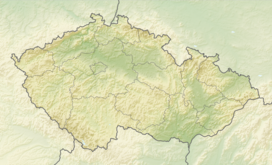Moravian-Silesian Beskids
This article includes a list of references, related reading, or external links, but its sources remain unclear because it lacks inline citations. (August 2014) |
| Moravian-Silesian Beskids | |
|---|---|
 Smrk mountain in early spring | |
| Highest point | |
| Peak | Lysá hora |
| Elevation | 1,323 m (4,341 ft) |
| Naming | |
| Native name | Moravskoslezské Beskydy Error {{native name checker}}: parameter value is malformed (help) |
| Geography | |
| Countries | Czech Republic and Slovakia |
| Regions | Moravian-Silesian (Czech Repub.) and Žilina (Slovakia) |
| Subdivisions | Klokočovská hornatina, Lysohorská hornatina and Radhošťská hornatina |
| Parent range | Western Beskids |
| Geology | |
| Orogeny | Alpine |
| Rock age | Miocene |
| Rock type | Godulian sandstone |
The Moravian–Silesian Beskids (Czech: ⓘ, Slovak: Moravsko-sliezske Beskydy) is a mountain range in the Czech Republic with a small part reaching to Slovakia. It lies on the historical division between Moravia and Silesia, hence the name. It is part of the Western Beskids, which is in turn part of the Outer Western Carpathians.
Geography
The mountains were created during the Alpine Orogeny in the Cenozoic. Geologically, they consist mainly of flysch deposits. In the north, they steeply rise nearly Template:Unit height over a rather flat landscape; in the south, they slowly merge with the Javorníky. In the south-west, they are separated from the Vsetínské vrchy by the Rožnovská Bečva valley; in the north-east, the Jablunkov Pass separates them from the Silesian Beskids.

The highest point is Lysá hora mountain at Template:Unit height, which is one of the rainiest places in the Czech Republic with around Template:Unit height of precipitation a year. Many legends are bound to Radhošť Mountain, 1,129 m (3,704 ft), which is one of the most visited places in the mountains together with the nearby Pustevny resort.
Smrk, with a height of 1,276 m (4,186 ft), is the second highest summit of the range. Its northern slope steeply rises from the surrounding lowlands and is separated from the rest of the mountains by the deep Ostravice River (in the east) and Čeladenka (in the west) river valleys; in the south, it merges in the lower Zadní hory (i.e. Rear mountains) area.
The Moravian-Silesian Beskids create the largest part of the Beskydy Landscape Protected Area (Template:Lang-cs or Template:Lang-cs for short). The mountains are 80% forested, though mainly by plantations of spruce which were in some parts severely damaged by emissions from the Ostrava industrial region. Originally, the mountains were covered by mixed forest with dominant beech which are preserved in many places. Recently, permanent occurrence of all three large Central European carnivores – lynx, bear and wolf – have been confirmed in the area.

There are many popular holiday resorts for both winter and summer activities, with centers in the towns under the mountains (Frýdlant nad Ostravicí, Frenštát pod Radhoštěm, Rožnov pod Radhoštěm) and also in smaller resorts, hamlets and chalets throughout the mountains, especially on the ridges. Parts of two euroregions, the Beskydy/Beskidy and Těšínské Slezsko/Śląsk Cieszyński, reach into the Moravian-Silesian Beskids.
References
- Ludvík, Marcel (1987). Beskydy, Turistický průvodce ČSSR. Praha: Olympia. 27-031-87.
{{cite book}}: Cite has empty unknown parameter:|coauthors=(help) - Rohlík, Jiří (2001). Moravskoslezské Beskydy, Soubor turistických map 1:50 000. Praha: TRASA, s.r.o. ISBN 80-85999-29-3.
{{cite book}}: Cite has empty unknown parameter:|coauthors=(help) - CHKO Beskydy Management. "CHKO Beskydy". Retrieved 2007-05-05.
{{cite web}}: Cite has empty unknown parameter:|coauthors=(help)


